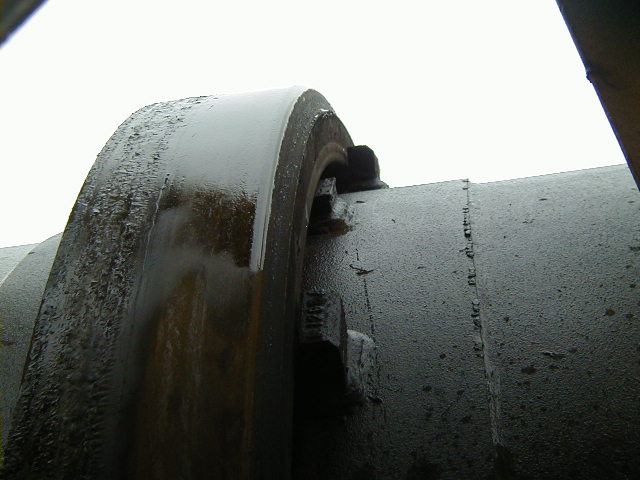Many asphalt plants suffer from trunnion and tire problems relating to misalignment and poor adjustment procedures. In past articles I have talked about various methods of repairs such as trunnion/tire grinding. When a plant is operated continually with its trunnions poorly adjusted the results can be devastating, requiring major repairs. Trunnion adjustment is a difficult task if poorly understood and mistakes can lead to serious damage.

Badly worn tire
A large part of my business involves teaching plant owners and operators the correct method of adjusting trunnions. In the following dissertation I am going to try to pass on to our readers an understanding of this valuable skill.
The first and most important issue is safety. I recommend that the circuit breakers for the drum drives be tripped and locked out as per OSHA regulations. Once this is done, remove all trunnion guards and loosen all adjustment plate mount bolts. It is also a good idea at this time to make sure all adjusting bolts are free of corrosion and will turn in their respective threads. Since the trunnions control ride height of the drum I recommend that the drum be centered in the inlet and outlet breaching at this time. To raise the drum in the discharge breaching simply move the trunnions at that end of the drum closer together. To lower it move them apart. When the vertical height is correct, but the drum is off-center to one side or the other we must move both trunnions in the same direction while maintaining their spacing. We must do this at both ends of the drum to get it correctly centered in both the inlet and discharge breaching.
Once this is done we are ready to begin the adjusting process. The first thing to do is to set all four trunnions to the neutral position. This means that the centerline of the trunnion shaft is exactly parallel to the centerline of the drum, and that when the drum rotates the trunnions will exert no influence on the drum’s position with respect to its thrust control mechanism. This is a difficult job requiring some exacting measurements.

Laser Tool saves time and time is money! Cost: $495.00
I’ve designed a tool that greatly simplifies this process. I am marketing a laser alignment tool utilizing a pair of industrial ruby lasers and scales with magnetic bases. To use these lasers we must first clean the sides of the tires and trunnions so the magnetic bases will adhere. Attach the two lasers to the same side of the trunnion, one on each side of the shaft. Set the scales on a smooth part of the tire at 6 o’clock and 9 o’clock. By reading where each laser’s red dot lands on our scales we are able to determine the amount of ‘skew’ in any particular trunnion. To set our trunnions to neutral, we would want both laser dots to read on the same number on their respective scales.
With all four trunnions set to neutral it is time to set them up so that they position our drum correctly between the thrust control rollers or flanges. Drums are set on a slope so that material will travel from the inlet to the outlet as the drum rotates. When our trunnions are set at neutral, gravity causes the drum to run to the lowest end, exerting considerable force on the lower thrust mechanism. In order to reduce the wear and tear on the thrust stop we must relieve this pressure. We do this by introducing a controlled amount of ‘skew’ into the trunnions. I like to set the drum so that when it is empty it just touches the lower thrust stop. At low rates of production it rides just off the bottom thrust stop and at high rates it rides up near the upper thrust stop.
In order to understand the process it is helpful to think of the trunnions as the front tires of a car. Stand so that you are facing in the direction that the tires roll over the trunnions. If you need to move the drum in a certain direction then you would steer the trunnion the same as the front tires on your car.
There are two very important rules that must be adhered to:
1- All four trunnions must be set exactly the same in order to avoid abnormal wear patterns.
2- Do not skew the trunnions any farther than absolutely necessary to keep the drum off the thrust stops.
I’ve never seen a set of trunnions that needed to be skewed more than 1/8” from neutral, and most drums only require about 1/16” of skew. When working on trunnion adjustments it is important to remember that, if things are not going right or something troubles you– Start over! Reset everything back to neutral and begin again. This is a time consuming process, but the end results are well worth the effort. I can usually do this job in 2 or 3 hours, depending on how hard it is to get at the bolts. Before the introduction of these lasers, this job could easily eat up a whole day of effort.
For additional information on this subject or help with any problems encountered contact Cliff Mansfield, Call 541-352-7942, 7:30am to 9:00pm Pacific Standard Time.
Email me- cmconsulting@hotmail.com

